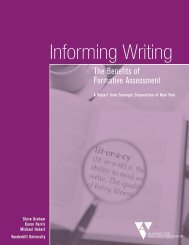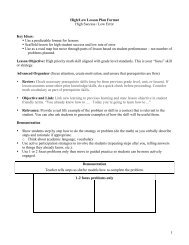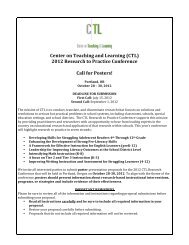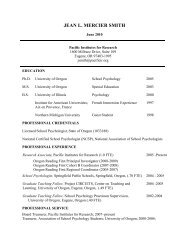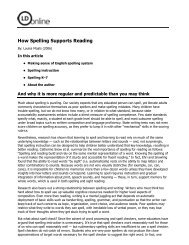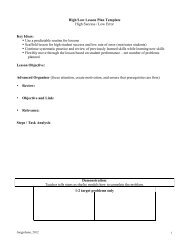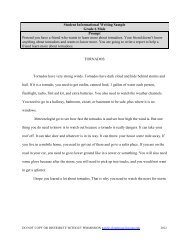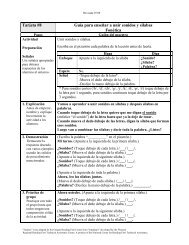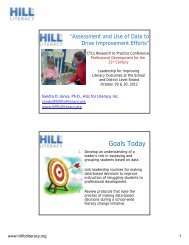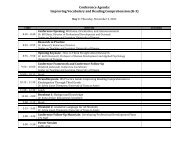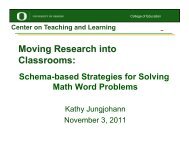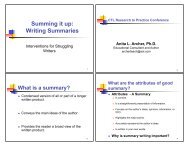Effective Classroom and Intervention Practices - Center on Teaching ...
Effective Classroom and Intervention Practices - Center on Teaching ...
Effective Classroom and Intervention Practices - Center on Teaching ...
- No tags were found...
You also want an ePaper? Increase the reach of your titles
YUMPU automatically turns print PDFs into web optimized ePapers that Google loves.
Improving Adolescent Literacy:<str<strong>on</strong>g>Effective</str<strong>on</strong>g> <str<strong>on</strong>g>Classroom</str<strong>on</strong>g> <str<strong>on</strong>g>and</str<strong>on</strong>g> <str<strong>on</strong>g>Interventi<strong>on</strong></str<strong>on</strong>g><str<strong>on</strong>g>Practices</str<strong>on</strong>g>: Practical Applicati<strong>on</strong>s & Implicati<strong>on</strong>sMeet the Feldmans !CTL Fall C<strong>on</strong>ferenceMoving Research Into <str<strong>on</strong>g>Classroom</str<strong>on</strong>g>sOctober 22/27, 2010Portl<str<strong>on</strong>g>and</str<strong>on</strong>g> ORDr. Kevin Feldmanwww. scoe.org/reading kfeldman@scoe.orgFeldman’s Biased Literacy Listserve1.) Validati<strong>on</strong>/Motivati<strong>on</strong> - explore the criticalapplicati<strong>on</strong>s/implicati<strong>on</strong>s of the IES PracticeGuide, Improving Adolescent Literacy: <str<strong>on</strong>g>Effective</str<strong>on</strong>g><str<strong>on</strong>g>Classroom</str<strong>on</strong>g> <str<strong>on</strong>g>and</str<strong>on</strong>g> <str<strong>on</strong>g>Interventi<strong>on</strong></str<strong>on</strong>g> <str<strong>on</strong>g>Practices</str<strong>on</strong>g>.2.) Explain, model, <str<strong>on</strong>g>and</str<strong>on</strong>g> critique classroom examples ofvarious strategies tied to the 5 key recommendati<strong>on</strong>sof the IES Practice Guide3.) Informati<strong>on</strong> & Resources to Investigate/Inquire/Explore Bey<strong>on</strong>d Today.Subscribe at:www.scoe.org/reading
How are our older readers doing…?NAEP (2009) Results for 8 th GradersThe status quo is working for about 1 in 38th Grade NAEP Passage:Ellis Isl<str<strong>on</strong>g>and</str<strong>on</strong>g> - Gateway to AmericaWhy does the author say " 'the l<str<strong>on</strong>g>and</str<strong>on</strong>g> of the free' was not sofree to every<strong>on</strong>e, after all"?Why does this passage c<strong>on</strong>tain the actual words of some ofthe immigrants?If you could ask <strong>on</strong>e of the immigrants a questi<strong>on</strong>, what elsewould you want to know about their experience <strong>on</strong> Ellis Is.?If you had lived in Armenia in 1892, would you haveimmigrated to America? Use informati<strong>on</strong> from the passage toexplain why or why not.Q: What do you notice about the nature of these questi<strong>on</strong>s?Implicati<strong>on</strong>s?12th Grade NAEP Passage:M.L. King - A Letter from a BirminghamJailIf King were alive today, what questi<strong>on</strong> would you mostwant to ask him about his views of civil disobedience thathehas not already answered in the letter? Explain why youchose this questi<strong>on</strong>.How does King use his distincti<strong>on</strong> between just <str<strong>on</strong>g>and</str<strong>on</strong>g> unjustlaws to support the need for civil disobedience?Look through the letter <str<strong>on</strong>g>and</str<strong>on</strong>g> find <strong>on</strong>e phrase that isparticularly meaningful for you. Explain your underst<str<strong>on</strong>g>and</str<strong>on</strong>g>ingof the phrase as it is used in the letter <str<strong>on</strong>g>and</str<strong>on</strong>g> why the phraseis meaningful to you.Q: What do you notice about the nature of these questi<strong>on</strong>s?Implicati<strong>on</strong>s for EVERY Gr. 6-12 teacher?
Critical Academic Literacy!Ability to critique, analyze , defend, explain, thinkdeeply - not just “<strong>on</strong> the surface”!”Argumentative literacy” (Graff, 2003)- ability to persuade, to debate, to clarify- explain why, evaluate, make judgments! Make a point <str<strong>on</strong>g>and</str<strong>on</strong>g> support it w/evidence <str<strong>on</strong>g>and</str<strong>on</strong>g> clearthinking, bey<strong>on</strong>d opini<strong>on</strong>/idiosyncratic experience! Use appropriate Academic Language - the vocabulary<str<strong>on</strong>g>and</str<strong>on</strong>g> c<strong>on</strong>venti<strong>on</strong>s of grammar <str<strong>on</strong>g>and</str<strong>on</strong>g> syntax dem<str<strong>on</strong>g>and</str<strong>on</strong>g>edby the discipline/situati<strong>on</strong>! Skillful in speaking & writing - expressive lang. artsAnd it must be TAUGHT - not simply assigned or expected!The Effects of Weaknesses in Oral Language<strong>on</strong> Reading Growth/Academic Achievement(Hirsch, 1996)Reading Age Level16151413121110 !987655 6 7 8 9 10 11 12 13 14 15 16Schools have not caused the gap...Chr<strong>on</strong>ological Agesadly, we unintenti<strong>on</strong>ally exacerbate it...High OralLanguage inKindergarten5.2 years differenceLow Oral Languagein KindergartenWhat Can We DoTo INTENTIONALLYNarrow This Gap?Goal: Make Thinking VisibleWow, in this class Inot <strong>on</strong>ly have to think,I’ve got to explainmy thinking !!EVERY student explainstheir thinking & receivesfeedback from peers<str<strong>on</strong>g>and</str<strong>on</strong>g> the teacher – DAILY !Normative Discourse StructureHow does this UNintenti<strong>on</strong>ally exacerbate the “gap”?Implicati<strong>on</strong>s for our work to improve adolescent literacy?
Premise: We Have an “Implementati<strong>on</strong> Gap”Knowing…. vs. DoingResearch … vs. PracticeIt is About Data-Based CHANGE...Bottom Line is still:1)! Eat better stuff2)!Exercise more3)!Mellow outTheYes - No - Why?“Block Scheduling <str<strong>on</strong>g>and</str<strong>on</strong>g> Project Based Learningare two examples of proven methods toimprove sec<strong>on</strong>dary student achievement.”Yes, I agree with this asserti<strong>on</strong> because_________.No, I do not agree with this asserti<strong>on</strong> because_______.Of Improving Literacy School Wide
The BIG Picture of School ImprovementJust Ask “Bill & Melinda” !A School-Wide Focus <strong>on</strong>:Improving!! Positive behavior; preventative, proactive, data basedhttp://www.pbis.org/ http://www.safe<str<strong>on</strong>g>and</str<strong>on</strong>g>civilschools.com/!! Instructi<strong>on</strong>; all c<strong>on</strong>tent areas & interventi<strong>on</strong> classes.research based strategies-data based decisi<strong>on</strong> makingInstructi<strong>on</strong>http://www.center<strong>on</strong>instructi<strong>on</strong>.org/!!! Guaranteed/Rigorous St<str<strong>on</strong>g>and</str<strong>on</strong>g>ards Based/ Core Curriculumhttp://www.corest<str<strong>on</strong>g>and</str<strong>on</strong>g>ards.org/ - unpacked & prioritized.!! Collaborative problem solving around data - formativeassessment tied to important outcomes (e.g. PLC/RtI work)http://www.rti4success.org/!! Leadership that “gets it”, supports it, expects/inspects<str<strong>on</strong>g>and</str<strong>on</strong>g> keeps the Focus <strong>on</strong> what matters most...The Power of Robust Instructi<strong>on</strong>alRoutines (i.e. require HOTS & AL)Such As “Yes – No – Why?”A few examples of where <strong>on</strong>e could use Y-N-Y routinely:! “Do Now” or Bell-Ringer warm up activity! “Exit Ticket” or summary activity to close a less<strong>on</strong>! To check for underst<str<strong>on</strong>g>and</str<strong>on</strong>g>ing at any point in a less<strong>on</strong>.STRUCTURE: Think – Write – Partner – GroupS must explain their thinking, use academic languageoral/written , receive feedback from at least <strong>on</strong>epeer <str<strong>on</strong>g>and</str<strong>on</strong>g> the teacher, wind up w/a correct copyfor later study, use, notes, etc.Many of the results were disappointing, Gates said Tuesday. Heacknowledged that the effort to break up big schools into smaller unitsdid not lead to the hoped-for gains in achievement, or an increase inthe numbers of students who went <strong>on</strong> to college.11/12/08 Seattle TimesEssential Attributes of ROBUSTInstructi<strong>on</strong> Across theGrades <str<strong>on</strong>g>and</str<strong>on</strong>g> C<strong>on</strong>tent Areas1) Engagement: Every<strong>on</strong>e Does Everything2) Language: Structured use of academicvocabulary in speaking/writing.3) Thinking: Structured use of HOTS(higher order thinking skills)* Of course, plus your essential c<strong>on</strong>tent area info!
This is Also Becoming a Nati<strong>on</strong>al FocusInstructi<strong>on</strong>al Rounds in Educati<strong>on</strong> ANetwork Approach to Improving <strong>Teaching</strong><str<strong>on</strong>g>and</str<strong>on</strong>g> Learning Elizabeth A. City,Richard F. Elmore, Sarah E. Fiarman,<str<strong>on</strong>g>and</str<strong>on</strong>g> Lee Teitel"<strong>Teaching</strong> causes learning." While this might seem obvious,teaching is often the last focus of educati<strong>on</strong>--shifted to the side byst<str<strong>on</strong>g>and</str<strong>on</strong>g>ardized testing, changing curricula, faculty room politics, overbearingor aloof administrators, <str<strong>on</strong>g>and</str<strong>on</strong>g> shrinking school budgets. And yet, argue thebook's authors, the "instructi<strong>on</strong>al core"--the essential interacti<strong>on</strong> betweenteacher, student, <str<strong>on</strong>g>and</str<strong>on</strong>g> c<strong>on</strong>tent that creates the basis of learning-- is thefirst place that schools should look to improve student learning.If you want to improve learning, you have to improve teaching !!!To every complex problem,there is a simple soluti<strong>on</strong>...that doesn’t work!Mark TwainLatest Research Summary:Sec<strong>on</strong>dary Literacywww.center<strong>on</strong>instructi<strong>on</strong>.orgThis practice guideprovides a heuristicfor improving sec<strong>on</strong>daryliteracy
heuristicheu•ris•tic n.Syn<strong>on</strong>ym Explanati<strong>on</strong>/Example ImageframeworkGreek root:heuriskein - tofindprocess or model forproblem solving(e.g. literacy),guidelines, a method orapproach0-1-2-3-4-5To effectively develop critical academic literacy skills withall types of students, sec<strong>on</strong>dary educators need a powerfulresearch informed/classroom tested ________. heuristicOur Heuristic: IES Recommendati<strong>on</strong>sAcross C<strong>on</strong>tent Areas in grades 6-121)! Provide explicit vocabulary instructi<strong>on</strong>2)! Provide direct & explicit comprehensi<strong>on</strong> strategyinstructi<strong>on</strong>3)! Provide opportunities for extended discussi<strong>on</strong> oftext/c<strong>on</strong>tent meaning <str<strong>on</strong>g>and</str<strong>on</strong>g> interpretati<strong>on</strong>s4) Increase motivati<strong>on</strong> <str<strong>on</strong>g>and</str<strong>on</strong>g> engagement in literacylearning (e.g. c<strong>on</strong>necti<strong>on</strong>s, choice, applicati<strong>on</strong>s, etc)5) Make available intensive individualized interventi<strong>on</strong>sfor struggling readers that can be provided byqualified specialists. (i.e. “tiered interventi<strong>on</strong>s”)Knowing what to do is actually the EASY part, organizing& guiding a school with systematic implementati<strong>on</strong> is thechallenge... Overcoming the “implementati<strong>on</strong> gap”..Analyze – Synthesize - EvaluateWhat did I do as a teacher in terms of:1)! Specific attributes of direct/explicitinstructi<strong>on</strong> – engagement, etc. to increasethe odds that learning would occur?2)! Specific attributes of effective vocabularyinstructi<strong>on</strong>/academic language development?Implicati<strong>on</strong>s for EVERY teacher 6-12c<strong>on</strong>cerned w/improving literacy?One Practical Tool to Bring the Heuristicto the <str<strong>on</strong>g>Classroom</str<strong>on</strong>g> LevelEngagement“Every<strong>on</strong>e doeseverything”Scaffolding*Support requiredfor entry levelcompetenceAcademic Rigor*Language (AL/Vocab)*Thinking (HOTS)
Introducing a Unit <strong>on</strong> Genocide: 10 th GradersCollect data to determine if the instructi<strong>on</strong> is; Engaging (all resp<strong>on</strong>ding),Academic (using AL/Vocabulary/HOTs), <str<strong>on</strong>g>and</str<strong>on</strong>g> Scaffolded (all supported)Also: www.center<strong>on</strong>instructi<strong>on</strong>.org
But, Houst<strong>on</strong> , we have a...What percentage of studentsactively participate in typicalsec<strong>on</strong>dary classroom discussi<strong>on</strong>s ??80/20 DilemmaDecades of research clearly dem<strong>on</strong>stratesapproximately 80% of the “doing” (ask/answering questi<strong>on</strong>s, discussing, explaining,writing, reading, etc.) is d<strong>on</strong>e by 20% of thestudents... WE MUST CHANGE THIS FACT!Engagement is NOT a Functi<strong>on</strong> of HowINTENSE the Teacher is!!We must support radicaltransformati<strong>on</strong> of this fact !!Or if your triple latte has kicked in!
And it’s NOT dependent up<strong>on</strong> howDRAMATIC the teacher happens to be…It IS how Resp<strong>on</strong>sive you getthe STUDENTS to Be!Ask Anita Archer!I do itWe do itRobin Williams in The Dead Poet’s SocietyOr the updated (Southerninfluenced) Versi<strong>on</strong>I do it - modeling (including thinking aloud)You do itcurricula - we must add it - Daily!** the “WE Do It”is essentially left out of ourStructured Engagement “tool kit”:Ensure ALL Are Resp<strong>on</strong>ding1)! Choral Resp<strong>on</strong>ses -pr<strong>on</strong>ounce it together- teacher cues students to resp<strong>on</strong>d (e.g. h<str<strong>on</strong>g>and</str<strong>on</strong>g> signal, voice, eyes)- physical resp<strong>on</strong>ses too; fingers under the word, chart, picture- “thumbs up when you know” (think time)We do it - teacher guidedY’all do it - partner practice(thanks to Ed Ellis, Alabama native)heart & soulof effectiveinstructi<strong>on</strong>...2) Partner Resp<strong>on</strong>ses- teacher assigns - provide a label/role “1’s tell 2’s”- alternate ranking (high with middle, middle with lower)- thoughtful questi<strong>on</strong>s/prompts/up & down Bloom’s tax<strong>on</strong>omy3) Written Resp<strong>on</strong>ses- focused prompts increase thinking, accountability, focus- structure academic language (e.g. sentence starters)You do it - independent practice (w/feedback)4) Individual Resp<strong>on</strong>ses (AFTER rehearsal/practice)- r<str<strong>on</strong>g>and</str<strong>on</strong>g>omly call <strong>on</strong> individuals, use “public voices”- complete sentences, using new vocabulary
SLANT Strategy (Ed Ellis, U of Alabama)Dr. Anita Archer Introducing 7thGraders to the Engagement “tool kit”S = Sit UpL = Listen (teacher/peers)A = Ask/AnswerN = Nod <str<strong>on</strong>g>and</str<strong>on</strong>g> NoteStudents resp<strong>on</strong>d primarilyto what we DO, not whatwe say…T = Track the teacher/speakerEngagement Comes Down Tothe Quantity & Quality of Student:Free to view/download at: www.scoe.org/readingBreaking Old Habits That D<strong>on</strong>’t Work!!! Saying - Oral Language!! Writing- Written Language!! Doing - pointing, touching,dem<strong>on</strong>strating, etc.** NEVER more than 2-10 Rule **
Comm<strong>on</strong> Instructi<strong>on</strong>alPractice “old school”Why It’s NOT Helpful& <str<strong>on</strong>g>Effective</str<strong>on</strong>g> Opti<strong>on</strong>sNo Opting Out = EVERYONE DOESEVERYTHING !! T asks questi<strong>on</strong>s & Sraise h<str<strong>on</strong>g>and</str<strong>on</strong>g>s to answer! T asks “does any<strong>on</strong>e know?”! T asks “who can tell me ?”! Round robin reading?! Students directed to looknew terms up, copydefiniti<strong>on</strong>s, usein a sentence.Every<strong>on</strong>e, stop <str<strong>on</strong>g>and</str<strong>on</strong>g> think,list, partners (1s – 2s),then “cold call” -all readyChoral, partner, cloze,or silent w/a taskExplicitly teach or “proveit” if known term, dicti<strong>on</strong>aryfor c<strong>on</strong>firmati<strong>on</strong>/elaborati<strong>on</strong>But what do I do when a student says “I d<strong>on</strong>’t know...”?Opti<strong>on</strong>s include:! Teachers provides – student repeats in c<strong>on</strong>text! Ask another student – first student repeats! Teacher prompts (scaffolds 1 st part or cues)! Teacher prompts a peer to cue the student! Think about it/check page _ “I’LL BE BACK”! IF YOU DID KNOW, What would it be....!If This is a Pattern...Soluti<strong>on</strong>? More “Fr<strong>on</strong>tloading”“can’t discuss if you d<strong>on</strong>’t have anything to say”For example:!! provide think time (signal readiness)!! require brief writing (evidence of readiness)!! provide sample answer!! brief partner/small group beforewhole class discussi<strong>on</strong>!! pre-teach a few key terms to use!! ask a more basic questi<strong>on</strong> to bridgeback to the higher level questi<strong>on</strong> etc.
Malcolm Gladwell“The Story of Success”“From Worst to First”How One CA High School Transformed viaA Relentless Focus <strong>on</strong> Improving Core Instructi<strong>on</strong>http://www1.waterford.k12.ca.us/The Power of Instructi<strong>on</strong> Norms toImprove <strong>Teaching</strong>, Thus AchievementAnother example of an “outlier” school...Example from Waterford HS1)! Less<strong>on</strong> Objectives: Clear - posted, could ask anystudent...know/be able to do.. (not just an activity)2) Teach First – then Check for Underst<str<strong>on</strong>g>and</str<strong>on</strong>g>ing –“I do it, We do it, You do it”3) Student Producti<strong>on</strong>; guided practice, independentpractice ALL Engaged, scaffold as needed4) Alignment of independent practice to the instructi<strong>on</strong>alobjectives (e.g. not practicing errors, or unrelated informati<strong>on</strong>) .5) C<strong>on</strong>cept Development: Focus in BIG ideas, corec<strong>on</strong>cepts/principles aligned to essential st<str<strong>on</strong>g>and</str<strong>on</strong>g>ards –are directly taught6) Meaningful Interacti<strong>on</strong> – ALL engaged, no byst<str<strong>on</strong>g>and</str<strong>on</strong>g>ers –Every<strong>on</strong>e does everything (e.g. no h<str<strong>on</strong>g>and</str<strong>on</strong>g> raising except forvolunteers).http://www1.waterford.k12.ca.us/
What do these “outliers” do?A most excellent starting place??Establishing ENGAGEMENT asan “Instructi<strong>on</strong>al Norm”norm, n. Latin norma date: 16741.! a widespread or usual practice2.!a pattern or trait taken to be typicalTake the AcademicLanguage Oath !!IES Rec. #1 Explicit Vocabulary Instructi<strong>on</strong>“I will ensure that EVERY singlestudent in my class speaks, <str<strong>on</strong>g>and</str<strong>on</strong>g>often also writes, at least <strong>on</strong>emeaningful academic sentenceEVERY day !”
Vocabulary is Important to All of Us!!Evidence Based School-wideAcademic Vocabulary Program1.! Engaging in AccountableWide Reading/Listening-Esp. N<strong>on</strong>-Ficti<strong>on</strong>2. Direct <strong>Teaching</strong> & AccountableUse of Important New Words;Oral/Written (sentences & more)4. Fostering WordC<strong>on</strong>sciousnesse.g. etymology, wordplay, word choice inwriting, etc.3. <strong>Teaching</strong> WordLearning Strategies,e.g. c<strong>on</strong>text/affixes, rootsdicti<strong>on</strong>aries, etc.- adapted from Graves, 2006Within a C<strong>on</strong>text of Active Structured Engagement:ALL Students Developing Their Academic Language Every DayBottom Line Summary?<str<strong>on</strong>g>Effective</str<strong>on</strong>g> vocabulary/academic languageinstructi<strong>on</strong> comes down to:C<strong>on</strong>venti<strong>on</strong>al Vocabulary “instructi<strong>on</strong>”w/an Excellent 6th Gr. TeacherC<strong>on</strong>necti<strong>on</strong> – new to the known, building that“semantic network” in the mind/brainUse – academic speaking <str<strong>on</strong>g>and</str<strong>on</strong>g> writing as we c<strong>on</strong>struct<str<strong>on</strong>g>and</str<strong>on</strong>g> apply knowledge (not simply memorize ormatch, multiple choice etc.)No single correct method or strategy – it will depend<strong>on</strong> how important the term is, how difficult it is to grasp,level of your students, c<strong>on</strong>tent area etc. ...but the sameessential architecture is there – C<strong>on</strong>nect & UsePlease note: is this instructi<strong>on</strong>; Inclusive (all resp<strong>on</strong>ding),Equitable (scaffolded), <str<strong>on</strong>g>and</str<strong>on</strong>g> Academic (using AL/Vocabulary/HOTs) ?
Instructi<strong>on</strong>al Guidelines (another Heuristic)for Explicitly <strong>Teaching</strong> a New Term1) Introduce (say together, syllables,identify part of speech, morphology, etc.)2) Explain BEFORE Define3) Provide Examples---------------4) Deepen Underst<str<strong>on</strong>g>and</str<strong>on</strong>g>ing5) Review & Coach Use“Quick Teach”Comp<strong>on</strong>ents of AcademicLanguage?! Vocabulary: the specialized words used in academicsettings: c<strong>on</strong>tent specific (e.g. metaphorical) & highuse academic terms (e.g. analyze, subsequent,comparatively, variable)! Syntax: the way words are arranged in order toform sentences or phrases! Grammar: the rules according to which the wordsof a language change their form <str<strong>on</strong>g>and</str<strong>on</strong>g> are combinedinto sentencesAcademic Language: Word Generati<strong>on</strong> Projecthttp://wordgenerati<strong>on</strong>.org/
Download FREE: http://carnegie.org/publicati<strong>on</strong>s/search-publicati<strong>on</strong>s/pub/315/<str<strong>on</strong>g>Practices</str<strong>on</strong>g> That Enhance Students’ ReadingThis report identifies a cluster of closely related instructi<strong>on</strong>al practices shown tobe effective in improving students’ reading. We have grouped these practiceswithin three core recommendati<strong>on</strong>s, here listed in order of the strength of theirsupporting evidence.I. HAVE STUDENTS WRITE ABOUT THE TEXTS THEY READ. Students’comprehensi<strong>on</strong> of science ,social studies, <str<strong>on</strong>g>and</str<strong>on</strong>g> language arts texts is improved whenthey write about what they read, specifically when they! Resp<strong>on</strong>d to a Text in Writing (Writing Pers<strong>on</strong>al Reacti<strong>on</strong>s, Analyzing <str<strong>on</strong>g>and</str<strong>on</strong>g> Interpreting! Write Summaries of a Text! Write Notes About a Text! Answer Questi<strong>on</strong>s About a Text in Writing, or Create <str<strong>on</strong>g>and</str<strong>on</strong>g> AnswerWritten Questi<strong>on</strong>s About a TextII. TEACH STUDENTS THE WRITING SKILLS AND PROCESSES THAT GOINTO CREATING TEXT.Students’ reading skills <str<strong>on</strong>g>and</str<strong>on</strong>g> comprehensi<strong>on</strong> are improved by learning the skills <str<strong>on</strong>g>and</str<strong>on</strong>g>processes that go into creating textBy Steve Graham & Michael HebertV<str<strong>on</strong>g>and</str<strong>on</strong>g>erbilt UniversityGreat Examples of Brief N<strong>on</strong>-Ficti<strong>on</strong>C<strong>on</strong>tent Specific Writing- Kinsella, Kinsella/Ward-SingerIII. INCREASE HOW MUCH STUDENTS WRITE. Students’ readingcomprehensi<strong>on</strong> is improved by having them increase how often they produce theirown texts.IES Rec. #2 – Explicit Strategies to boost1)! Power Sentences2)! 5 min paper (Topic 1-2 detail sentences)3)! 10 min paper (Topic 2-3 detail sentences)T<strong>on</strong>s of resources FREE to download from Dr. Kate:http://www.sccoe.org/depts/ell/kinsella.aspCORE website for Kate’s presentati<strong>on</strong> & materialsposted for downloading www.corelearn.com
Cognitive Strategies that ImproveReading/Listening Comprehensi<strong>on</strong>!!!“Plans for Thinking”"! Summarizing & paraphrasing"! Text structure/patterns/organizati<strong>on</strong>"! Questi<strong>on</strong>ing asking/answering"! Visualizing/C<strong>on</strong>necting (Graphic Org)"! Predicting & m<strong>on</strong>itoring"! Self regulati<strong>on</strong> & “fix up” strategiesSummarizati<strong>on</strong>What Must a Reader Do in Order toSummarize a Segment of Text?#! Identify the gist/topic/main idea#! Identify related details#! Determine relative import of the details- separate trivial from essential#! Put informati<strong>on</strong> into own words - paraphrase#! Combine - synthesize - c<strong>on</strong>solidate- “cook it down” - extract the essenceParagraph Shrinking:<strong>Teaching</strong> Summarizati<strong>on</strong>Same Strategy - Gen Ed - 8th Gr. Historyw/Dr. Anita Archer$! Paragraph Shrinking (summarize/paraphrase)1. Name the”who/what” the paragraph is about2. Identify the most important detailsabout who/what3. State the “gist” in 10 words or less4. Record each “gist statement” in summary notesInclusive – Equitable – Academic (language/thinking)?
8 th Grade Literacy <str<strong>on</strong>g>Interventi<strong>on</strong></str<strong>on</strong>g>(Lbook – READ 180) T<strong>on</strong>ya Ward-SingerAnother: CSR “Collaborative Strategic Reading”(Vaughn & Klingner)Manual from www.sopriswest.comBefore reading1. PREVIEW- brainstorm- preread- predictCSR MapAfter reading4. WRAP UP- ask/generate questi<strong>on</strong>s- review- record in learning log2. CLICK & CLUNK- note hard parts- fix clunks- clarifyDuring Reading3. GET THE GIST- summarize/paraphrase- compare/c<strong>on</strong>trast- note in learning logQAR: Questi<strong>on</strong> - Answer - Relati<strong>on</strong>ships(Raphael & Au, 2005Why? - research validated framework for teachingstudents how to think about questi<strong>on</strong> types &the relati<strong>on</strong>ship between questi<strong>on</strong>s & the text.In the Book (literal)!Right There (underline it)!Think & Search (put togetherfrom more than <strong>on</strong>e locati<strong>on</strong>in the text)In my Head (use of PK)!Author <str<strong>on</strong>g>and</str<strong>on</strong>g> Me - inference, combinetext info & prior knowledge toresp<strong>on</strong>d! On My Own - d<strong>on</strong>’t require readingof the text! students learn how to think about questi<strong>on</strong>s(metacogniti<strong>on</strong>) <str<strong>on</strong>g>and</str<strong>on</strong>g> become more strategic - resp<strong>on</strong>ddifferently based <strong>on</strong> the task/questi<strong>on</strong> typeCarol Lee et al. Reading in the Disciplines - http://carnegie.org/publicati<strong>on</strong>s/
Of Course the bottom line is...Putting It ALL Together: SupportingImproved Literacy – Site Based Suggesti<strong>on</strong>s1)! Share relevant informati<strong>on</strong> w/every<strong>on</strong>e (e.g. IESPractice Guides, research summaries, etc.).2)! Collect baseline data re: key domains (e.g. % of engagementin class) & create Norms for Instructi<strong>on</strong>3)! Work directly in classrooms, co-planning/teaching/modeling4) “Instructi<strong>on</strong>al Tours” – observati<strong>on</strong>s tied to agreed up<strong>on</strong>norms/key focal areas (e.g. engagement, vocabulary, n<strong>on</strong>ficti<strong>on</strong>writing) w/feedback & planning for change.5)! Collect data based <strong>on</strong> student performance/work-feedbackto faculty via email the same day...6)! Provide focused professi<strong>on</strong>al development – model/demoeffective practices/short video clips etc. FOCUS FOCUS!Thanks for Attending !Additi<strong>on</strong>al FREE resources/videos/etc. are posted atwww.scoe.org/readingPlease send al<strong>on</strong>g anyquesti<strong>on</strong>s; kfeldman@scoe.orgKevin Feldman



